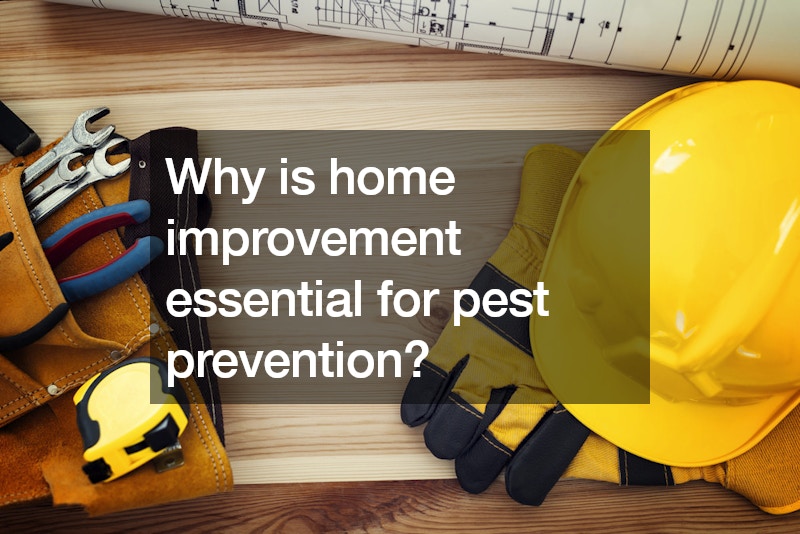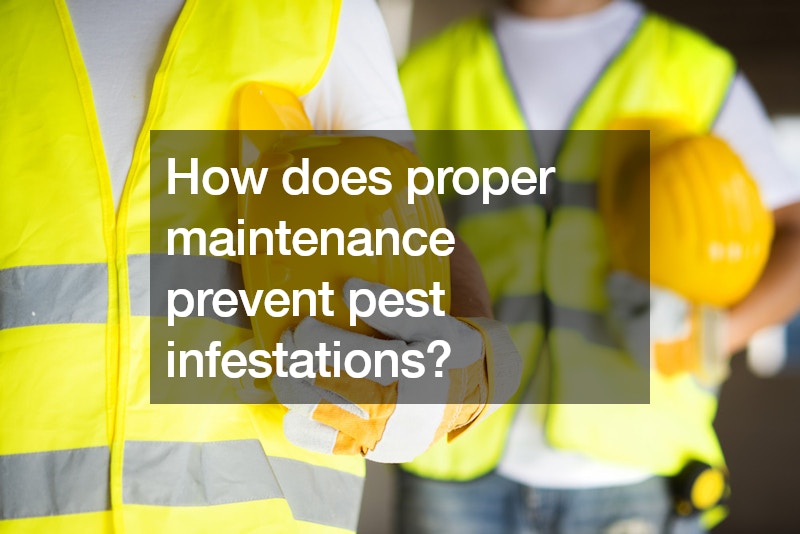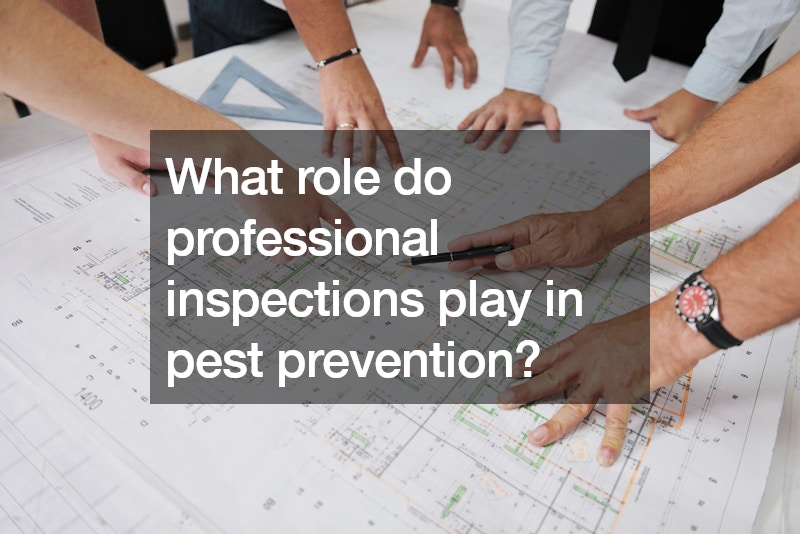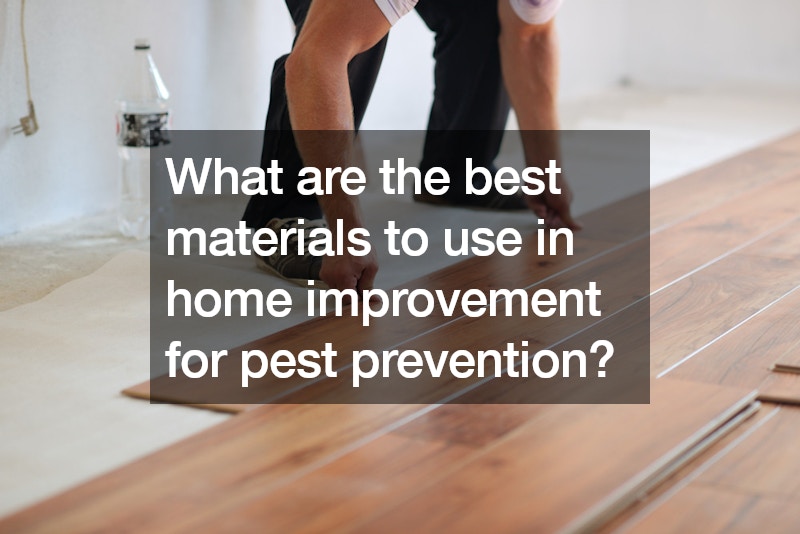Introduction
Home improvement encompasses more than just aesthetic enhancements; it is integral to maintaining a healthy and safe living environment, particularly in the realm of pest prevention. This article explores the interconnectedness between home improvement practices and effective pest control strategies, emphasizing the importance of proactive measures in safeguarding homes against pest infestations.
Why is home improvement essential for pest prevention?

Structural Integrity
Maintaining the structural integrity of your home is paramount in keeping pests out and ensuring the longevity of your property. Elements such as residential siding replacement not only enhance the appearance of your home but also serve as robust barriers against pests. Cracks or gaps in walls, foundations, or roofing can provide easy entry points for pests like rodents, insects, and even birds. By promptly repairing these vulnerabilities with durable materials and professional craftsmanship, homeowners can significantly reduce the risk of pest infestations.
Investing in barrier methods is equally crucial. High-quality materials and meticulous installation are key factors in creating effective barriers that deter pests. For instance, ensuring doors and windows are properly fitted with screens installed by reputable window replacement companies prevents insects from entering while allowing ventilation. These barriers not only keep pests out but also contribute to energy efficiency by reducing the need for excessive heating or cooling, thus enhancing overall home comfort and sustainability.
What common home improvements help in pest control?
Sealing Cracks and Crevices
Sealing cracks and crevices around the home is a fundamental step in pest prevention. Pests often exploit these tiny openings to gain access indoors, where they can find shelter, food, and water. By using caulking or weatherstripping, particularly around entry points like doors, windows, pipes, and vents, homeowners create a formidable defense against pests. Regular inspections to identify and seal new gaps as they appear further fortify these defenses, ensuring ongoing protection against pest intrusion.
Proper insulation plays a significant role in pest control as well. Upgrading insulation not only improves energy efficiency by reducing heating and cooling costs but also helps maintain consistent indoor temperatures. This reduction in temperature fluctuations makes the environment less attractive to pests seeking refuge from extreme weather conditions. Additionally, quality insulation materials such as foam or cellulose minimize nesting opportunities for pests like rodents, who may otherwise seek warmth and shelter within walls or attics.
How does proper maintenance prevent pest infestations?

Regular Cleaning
The importance of regular cleaning cannot be overstated in pest prevention. Clutter and debris provide hiding spots and nesting opportunities for pests, making it crucial to maintain a tidy living space. Vacuuming carpets, sweeping floors, and promptly disposing of garbage remove potential food sources that attract pests. In kitchen areas, ensuring countertops, sinks, and cabinets are kept clean and free of crumbs reduces the risk of attracting ants, cockroaches, and other pests drawn to food residues.
Effective outdoor upkeep is equally essential. Addressing issues such as roofing hail damage promptly prevents water leaks that can lead to moisture buildup and mold growth—conditions that attract pests seeking water sources. Regularly trimming vegetation and maintaining landscaping not only enhances curb appeal but also reduces harborage areas for pests like rodents and mosquitoes. Keeping outdoor areas clear of debris and maintaining proper drainage minimizes standing water, which can serve as breeding grounds for mosquitoes and other water-loving pests.
Can home improvement projects lead to pest problems?
Poor Planning
While home improvement projects offer opportunities to enhance comfort and functionality, poor planning can inadvertently create vulnerabilities that attract pests. For example, renovations that disrupt existing pest barriers or create new entry points, if not properly managed, can invite pests indoors. It’s essential to consult with professionals who understand pest dynamics and can recommend preventive measures during the planning stages. Incorporating pest-resistant materials and design features into renovation plans helps mitigate these risks and ensures long-term protection against unwanted intruders.
Inadequate materials can compromise the effectiveness of home improvements aimed at pest prevention. Choosing substandard materials or failing to use appropriate treatments can weaken barriers against pests or create conditions conducive to infestations. For instance, using untreated wood in construction projects may attract wood-boring insects like termites or carpenter ants, leading to structural damage over time. Investing in quality materials that are resistant to pests and decay minimizes maintenance costs and reduces the likelihood of future pest problems. Contact termite control services.
DIY Risks
While DIY projects can be fulfilling and cost-effective, they also pose risks when it comes to pest prevention. A lack of professional expertise and knowledge about pest behaviors may result in unintentional mistakes that attract pests. For instance, improperly sealed gaps or ineffective pest control methods can inadvertently encourage pest activity rather than deter it. Moreover, DIY projects may overlook comprehensive pest prevention strategies that professionals routinely employ, such as integrated pest management (IPM) techniques that address underlying causes of pest issues.
To mitigate these risks, homeowners should educate themselves on effective pest prevention methods or consult with pest control professionals before embarking on DIY projects. Incorporating pest-resistant materials and proactive measures into DIY plans ensures that improvements not only enhance the home’s functionality and appearance but also safeguard against potential pest threats. By balancing creativity with practicality and informed decision-making, homeowners can achieve successful home improvements while minimizing the risk of pest problems with the help of an extermination service.
What role do professional inspections play in pest prevention?

Routine Pest Inspections
Engaging local pest control companies for routine inspections is a proactive approach to pest prevention. These inspections allow trained professionals to identify early signs of pest activity, potential entry points, and conducive conditions within and around the home. Early detection enables prompt intervention strategies, such as targeted treatments or sealing vulnerabilities, before pests establish significant populations or cause damage. Routine inspections are particularly crucial for homes in areas prone to specific pests or environmental conditions that attract pests.
Professional pest inspections are equally essential before purchasing a home. A thorough assessment by pest control experts helps potential homeowners identify existing pest issues and assess the property’s susceptibility to future infestations. Addressing these concerns before finalizing a purchase allows buyers to negotiate necessary repairs or treatments and ensures they are making an informed investment decision. Post-renovation checks are also recommended to verify that recent modifications have not inadvertently compromised pest barriers or created new vulnerabilities that require attention.
How does landscaping affect pest control?
Garden Maintenance
Proper garden maintenance by a professional tree company not only enhances the aesthetic appeal of outdoor spaces but also plays a critical role in pest control. Regular trimming of trees and shrubs reduces hiding places for pests and minimizes pathways that pests use to access the home. Pruning also improves air circulation and sunlight exposure, creating less favorable conditions for pests that thrive in dense foliage. Additionally, removing dead or diseased plants promptly prevents pests from using them as breeding grounds or sources of food.
Strategic use of mulch is another landscaping practice that influences pest control. Choosing organic mulch and maintaining an appropriate depth around plants helps regulate soil temperature and moisture levels while suppressing weed growth. This reduces the need for excessive watering, which can attract pests like ants and sowbugs seeking moist environments. Opting for mulch made from pest-resistant materials, such as cedar or cypress, further enhances its effectiveness in deterring pests and promoting plant health. A tree removal may also help.
What are the best materials to use in home improvement for pest prevention?

Pest-Resistant Woods
Selecting pest-resistant woods, such as cedar or redwood, for construction and water restoration companies helps mitigate the risk of pest infestations. These woods contain natural oils and resins that repel insects like termites and carpenter ants, making them less susceptible to damage over time. Using treated lumber for outdoor structures like decks or fences provides added protection against decay and pest infestations, ensuring durability and longevity without attracting wood-boring pests.
Non-porous materials, such as metal, plastic, or composite materials, are highly effective in preventing pest access to vulnerable areas of the home. These materials offer smooth surfaces that pests cannot easily chew through or burrow into, unlike traditional materials like wood or concrete which may develop cracks or crevices over time. Incorporating non-porous materials into construction projects, particularly in areas prone to moisture or humidity, reduces the likelihood of pest infestations and simplifies maintenance efforts.
How can ventilation systems affect pest prevention?
Proper Ventilation
Effective ventilation systems are essential for maintaining indoor air quality and reducing moisture levels, which are critical factors in pest prevention. Properly ventilated spaces inhibit mold and mildew growth, which attract moisture-loving pests like cockroaches and silverfish. Additionally, adequate airflow helps regulate indoor temperatures, creating less favorable conditions for pests that thrive in warm or humid environments. Regular maintenance of ventilation systems, including cleaning ducts and replacing filters, ensures optimal performance and minimizes the risk of pest-related issues.
Using dehumidifiers in damp or humid areas further enhances pest prevention efforts by reducing excess moisture that pests require for survival. By maintaining relative humidity levels below 50%, homeowners can discourage pests from establishing nests or seeking shelter indoors. Combining proper ventilation with dehumidification strategies creates an inhospitable environment for pests while promoting comfort and energy efficiency within the home.
How does decluttering help in pest control?
Reducing Hiding Spots
Decluttering is a fundamental practice in pest control as it eliminates hiding spots and nesting areas that pests exploit. Piles of newspapers, stacks of boxes, and cluttered storage spaces provide ideal environments for pests to hide, breed, and forage for food. By organizing and reducing clutter, homeowners expose potential pest-hiding spots, making it easier to detect and address pest infestations early. Regular decluttering efforts also promote air circulation and light penetration, creating less favorable conditions for pests that prefer dark, secluded areas.
Organized storage practices further contribute to pest prevention by utilizing sealed containers and shelving units to store items off the ground and away from walls. Sealed containers prevent pests from accessing stored goods while shelving units minimize contact between stored items and potential pest pathways. Periodic inspections of stored items allow homeowners to identify signs of pest activity, such as droppings or gnaw marks, and take appropriate preventive measures before infestations escalate.
Periodic Clear-Outs
Regularly conducting clear-outs of unused or unnecessary items reduces clutter accumulation and minimizes potential hiding places for pests. Periodic clear-outs also facilitate thorough cleaning of storage areas, ensuring that any accumulated debris or food residues are promptly removed. By maintaining a clutter-free environment, homeowners not only enhance the overall cleanliness of their living spaces but also reduce the likelihood of attracting pests seeking shelter or food sources. Contact cleaning and restoration services.
Implementing these decluttering practices as part of routine household maintenance promotes a proactive approach to pest control. By staying vigilant and proactive in managing clutter and storage areas, homeowners can effectively minimize the risk of pest infestations and maintain a pest-free living environment.
Are there eco-friendly home improvement options for pest prevention?
Natural Pest Repellent
Opting for natural pest repellents and deterrents offers effective pest control solutions without relying on harsh chemicals. Essential oils such as peppermint, lavender, and citrus are known for their ability to repel pests like ants, spiders, and mosquitoes. These natural repellents can be applied safely around the home, including in kitchens, bathrooms, and outdoor areas, to create barriers that discourage pests from entering living spaces. Additionally, incorporating plants known for their pest-repellent properties, such as marigolds or basil, in landscaping and garden areas further enhances natural pest control efforts.
Choosing green building materials promotes sustainability while reducing the risk of attracting pests. Materials like recycled steel, bamboo, or reclaimed wood offer durable alternatives that are less susceptible to pest damage and decay. Green building practices, such as using energy-efficient insulation and sealing materials, not only enhance the home’s environmental footprint but also contribute to a healthier indoor environment less conducive to pest infestations.
Sustainable Practices
Adopting sustainable practices in home improvement not only benefits the environment but also supports effective pest prevention strategies. Proper waste management, such as composting organic materials and disposing of waste responsibly, reduces potential food sources for pests and minimizes their attraction to the property. Energy-efficient upgrades, such as installing solar panels or using low-energy appliances, contribute to a stable indoor environment that is less prone to temperature fluctuations and moisture buildup—conditions that attract pests seeking shelter or water sources.
In conclusion, integrating eco-friendly home improvement options with proactive pest prevention strategies enhances the overall sustainability and resilience of residential environments. By prioritizing natural repellents, green building materials, and sustainable practices, homeowners can effectively mitigate pest risks while promoting a healthier, more environmentally friendly living space. Embracing these practices not only safeguards homes against pests but also contributes to long-term environmental stewardship and enhanced quality of life for residents.
In conclusion, integrating home improvement practices with pest prevention strategies is indispensable for safeguarding your home and family. By investing in structural integrity, maintenance, and professional inspections, homeowners can create a resilient living environment that wards off pests effectively. Prioritizing these measures not only enhances comfort and safety but also promotes long-term health benefits by mitigating the risks associated with pest infestations. As homeowners strive for beautiful and functional spaces, ensuring they are pest-resistant should always be a top priority.
